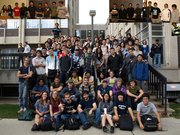|
|
| Line 129: |
Line 129: |
|
|} |
|
|} |
|
|} |
|
|} |
|
|
|
|
|
|
|
|
Multiplication is repeated addition. |
|
|
|
|
|
<math>23 \times 27 = \begin{matrix} 27 \\ \overbrace{23 + 23 + 23 + \cdots + 23} \end{matrix} = 621</math> |
|
|
|
|
|
<math>27 \times 23 = \begin{matrix} 23 \\ \overbrace{27 + 27 + 27 + \cdots + 27} \end{matrix} = 621</math> |
|
|
|
|
|
One may interpret this as counting the units in a 23×27 rectangle; one may choose to count along either 23 rows or 27 columns, but both ways lead to the same answer. |
|
|
|
|
|
|
|
|
Exponentiation is repeated multiplication, but it does not have the same properties as multiplication; 2<sup>3</sup> = 8, but 3<sup>2</sup> = 9. |
|
|
|
|
|
|
|
|
'''Theorem''': <math>\,\! F_p </math> for <math>p > 1</math> is a field ''iff'' <small>([http://en.wikipedia.org/wiki/If_and_only_if if and only if])</small> <math>p</math> is a prime number |
|
'''Theorem''': <math>\,\! F_p </math> for <math>p > 1</math> is a field ''iff'' <small>([http://en.wikipedia.org/wiki/If_and_only_if if and only if])</small> <math>p</math> is a prime number |
Revision as of 00:34, 16 September 2009
| Additions to the MAT 240 web site no longer count towards good deed points
|
| #
|
Week of...
|
Notes and Links
|
| 1
|
Sep 7
|
Tue, About, Thu
|
| 2
|
Sep 14
|
Tue, HW1, HW1 Solution, Thu
|
| 3
|
Sep 21
|
Tue, HW2, HW2 Solution, Thu, Photo
|
| 4
|
Sep 28
|
Tue, HW3, HW3 Solution, Thu
|
| 5
|
Oct 5
|
Tue, HW4, HW4 Solution, Thu,
|
| 6
|
Oct 12
|
Tue, Thu
|
| 7
|
Oct 19
|
Tue, HW5, HW5 Solution, Term Test on Thu
|
| 8
|
Oct 26
|
Tue, Why LinAlg?, HW6, HW6 Solution, Thu
|
| 9
|
Nov 2
|
Tue, MIT LinAlg, Thu
|
| 10
|
Nov 9
|
Tue, HW7, HW7 Solution Thu
|
| 11
|
Nov 16
|
Tue, HW8, HW8 Solution, Thu
|
| 12
|
Nov 23
|
Tue, HW9, HW9 Solution, Thu
|
| 13
|
Nov 30
|
Tue, On the final, Thu
|
| S
|
Dec 7
|
Office Hours
|
| F
|
Dec 14
|
Final on Dec 16
|
| To Do List
|
| The Algebra Song!
|
| Register of Good Deeds
|
| Misplaced Material
|

Add your name / see who's in!
|
|
The real numbers A set  with two binary operators and two special elements
with two binary operators and two special elements  s.t.
s.t.








- Note: or means inclusive or in math.

Definition: A field is a set F with two binary operators  : F×F → F,
: F×F → F,  : F×F → F and two elements
: F×F → F and two elements  s.t.
s.t.





Examples








 is not a field because not every element has a multiplicative inverse.
is not a field because not every element has a multiplicative inverse.
- Let

- Then

- Therefore F4 fails; there is no number b in F6 s.t. a · b = 1
|
|
|
Ex. 5
| + |
0 |
1 |
2 |
3 |
4 |
5 |
6
|
| 0
|
0 |
1 |
2 |
3 |
4 |
5 |
6
|
| 1
|
1 |
2 |
3 |
4 |
5 |
6 |
0
|
| 2
|
2 |
3 |
4 |
5 |
6 |
0 |
1
|
| 3
|
3 |
4 |
5 |
6 |
0 |
1 |
2
|
| 4
|
4 |
5 |
6 |
0 |
1 |
2 |
3
|
| 5
|
5 |
6 |
0 |
1 |
2 |
3 |
4
|
| 6
|
6 |
0 |
1 |
2 |
3 |
4 |
5
|
|
Ex. 5
| × |
0 |
1 |
2 |
3 |
4 |
5 |
6
|
| 0
|
0 |
0 |
0 |
0 |
0 |
0 |
0
|
| 1
|
0 |
1 |
2 |
3 |
4 |
5 |
6
|
| 2
|
0 |
2 |
4 |
6 |
1 |
3 |
5
|
| 3
|
0 |
3 |
6 |
2 |
5 |
1 |
4
|
| 4
|
0 |
4 |
1 |
5 |
2 |
6 |
3
|
| 5
|
0 |
5 |
3 |
1 |
6 |
4 |
2
|
| 6
|
0 |
6 |
5 |
4 |
3 |
2 |
1
|
|
Multiplication is repeated addition.


One may interpret this as counting the units in a 23×27 rectangle; one may choose to count along either 23 rows or 27 columns, but both ways lead to the same answer.
Exponentiation is repeated multiplication, but it does not have the same properties as multiplication; 23 = 8, but 32 = 9.
Theorem:  for
for  is a field iff (if and only if)
is a field iff (if and only if)  is a prime number
is a prime number
Tedious Theorem
 "cancellation property"
"cancellation property"
- Proof:
- By F4,


 by F2
by F2 by choice of d
by choice of d by F3
by F3


- Proof:

 by F3
by F3 by adding the additive inverse of a to both sides
by adding the additive inverse of a to both sides







- Proof:
 by F3
by F3 by F5
by F5

- So there is no 0−1


- (Bonus)

Quotation of the Day
......
































































